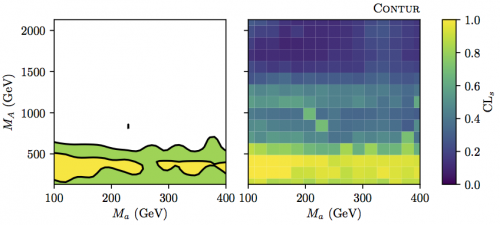2HDM+Pseudoscalar comparisons
Jon B, Priscilla P, David Y…
Preliminary study with Contur here with links to the model and to the ATLAS summary paper. (NB. This is the model also being considered from the four top point of view.)
Progress so far/things to work on:
Bug fix in ATLAS $H \rightarrow \gamma\gamma$
See here.
b-jet vetoes and fiducial phase-space
The CMS $H \rightarrow WW$ measurement 1606.01522 which gives the main sensitivity in the study linked above has a b-jet veto applied at detector-level, which is not given in the fiducial phase space and therefore not implemented in rivet. The effect of the b-jet veto is extrapolated out in the unfolding, which therefore assumed the SM. In addition (but related) there is a very large data-driven background subtraction of $WW$ and $t\bar{t}$ SM events. Overall, this means the exclusion for this model (and for most models) from this analysis is is unreliable. (In this case, many of the BSM events entering the fiducial regions will have b-jets since they originate from top and charge Higgs decays.) This analysis should only really be used to exclude anomalous contributions to the $H \rightarrow WW$ cross section which look SM-like (ie do not have any b-jets, for example). More useful for EFT-type studies than Contur.
Exclusion with the CMS $H \rightarrow WW$ omitted
( pdf)
Checking through the other $WW$ analyses currently being used by Contur, several have jet vetoes and background subtraction, but all have the jet veto applied in the fiducial phase space and in the Rivet routine; in addition the background subtractions are much smaller and generally use the SM predictions rather than data. This presumably explains their lower apparent sensitivity, but means the sensitivity that remains is reliable.
The ATLAS $H \rightarrow WW$ 1604.02997 is not used in Contur to date, but is actually a bit more useable than the CMS paper, since the jets are included in the fiducial definition. However, there is still a large data-driven background subtraction, based upon a b-tagged control region.
This is the gzipped directory with the sensitivity plots for the various pools: gzipped tar file
We could think of implementing a b-jet veto as an option in the rivet routine, but this would only be approximate, since the analysis cut is done at the detector level with a combination of a b-tagging discriminant (above 30 GeV $p_T$) and a soft muon requirement (with some lower efficiency between 15 and 30 GeV) and we don't have the smearing or efficiency functions. The net result would presumably be to reduce the sensitivity toward the level of the other $WW$ routines we have, and the large data-driven background subtraction would remain a concern.
Note that the jets+MET analysis has some (weak) sensitivity across quite a wide range… worth pursuing with higher lumi.

